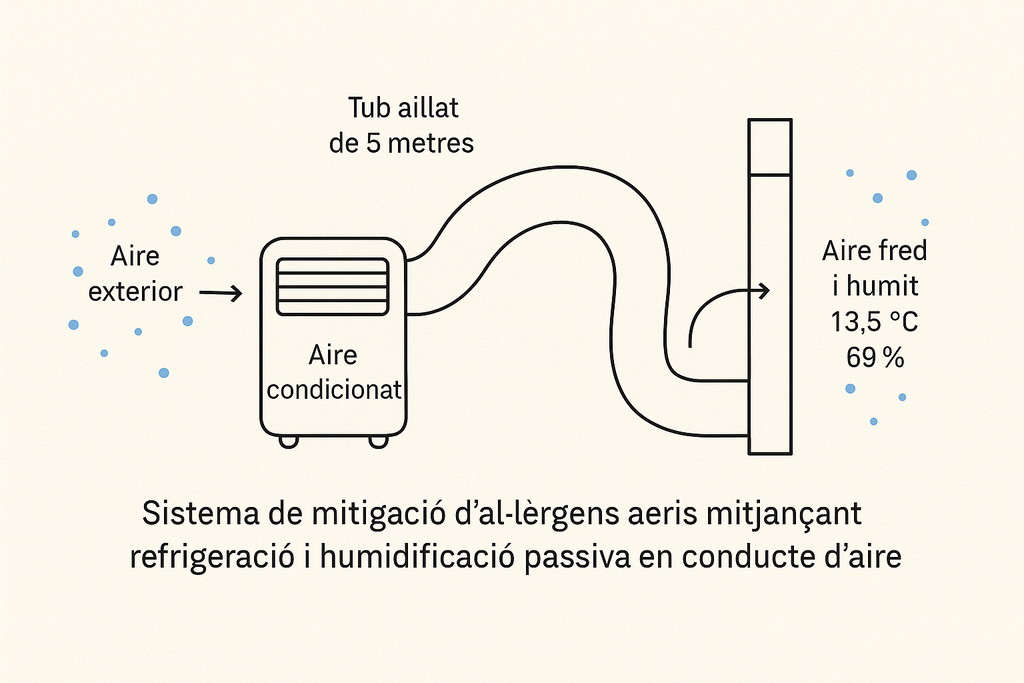|
🔬 Mitigació passiva dels al·lèrgens a l'aire mitjançant refredament localitzat i humitat controlada
Resum tècnic: Aquest document descriu un mètode experimental per reduir l'activitat al·lergènica del pol·len a l'aire mitjançant l'aplicació d'una combinació de baixa temperatura, humitat elevada i temps d'exposició controlat. El sistema, completament passiu i implementable amb materials bàsics, pot complementar o substituir la filtració mecànica en entorns on l'energia, l'espai o la capacitat de manteniment són limitats. Configuració bàsica: Qualsevol sistema d'aire condicionat capaç d'aspirar aire exterior i canalitzar-lo a l'interior a través d'un conducte aïllat. La configuració ideal inclou un conducte de sortida llarg (per exemple, 5 metres) amb aïllament tèrmic, que permet el subministrament d'aire fresc i humit a baixa velocitat a l'espai habitable. Mecanisme d'acció: L'aire exterior es refreda a aproximadament 13-15 °C, augmentant significativament la seva humitat relativa (per exemple, del 44% al 69%). El pol·len suspès a l'aire viatja durant uns 3 segons a través d'un ambient saturat, cosa que pot: iniciar la hidratació de la paret exterior (exina), reduir la flotabilitat i afavorir la sedimentació, reduir o inhibir temporalment l'activitat al·lergènica. L'aire modificat entra a l'habitació com una brisa fresca i humida, amb un potencial d'irritació respiratòria reduït. Aplicabilitat: Reproduïble mitjançant sistemes d'aire condicionat per conductes que permeten l'entrada d'aire extern i vies de sortida ampliades i aïllades. Es pot millorar amb recirculació parcial, humidificadors intermedis o seccions dissenyades per a la caiguda de pressió. Particularment útil en entorns rurals, edificis antics o zones amb infraestructura mínima. L'eficàcia pot variar segons els factors ambientals (temperatura, humitat, tipus de pol·len, flux d'aire) i el sistema s'ha d'ajustar per a cada context. Beneficis: Reducció efectiva dels símptomes en individus amb al·lèrgies greus al pol·len. Baix cost, manteniment mínim. Sense emissions d'ozó ni subproductes. Limitacions: No elimina físicament el pol·len. Els resultats depenen del flux d'aire, la temperatura exterior i la saturació d'humitat. Risc de condensació excessiva si s'implementa malament. |
|
 esquema.png esquema.png |
|
Passive Mitigation of Airborne Allergens Through Localized Cooling and Controlled Humidity
Technical Summary: This document outlines an experimental method to reduce the allergenic activity of airborne pollen by applying a combination of low temperature, elevated humidity, and controlled exposure time. The system, entirely passive and implementable with basic materials, can complement or replace mechanical filtration in environments where energy, space, or maintenance capacity is limited. Base Setup: Any air conditioning system capable of drawing in outdoor air and channeling it indoors through an insulated duct. The ideal configuration includes a long output duct (e.g., 5 meters) with thermal insulation, enabling the delivery of cool, humid air at low velocity into the living space. Mechanism of Action: Outdoor air is cooled to approximately 13–15 °C, significantly increasing its relative humidity (e.g., from 44% to 69%). Pollen suspended in the air travels for about 3 seconds through a saturated environment, which may: initiate hydration of the outer wall (exine), reduce buoyancy and encourage settling, temporarily reduce or inhibit allergenic activity. The modified air enters the room as a cool, humid breeze, with reduced respiratory irritation potential. Applicability: Reproducible using ducted air conditioning systems that allow external air intake and extended, insulated output paths. Can be enhanced with partial recirculation, intermediate humidifiers, or sections designed for pressure drop. Particularly useful in rural settings, older buildings, or areas with minimal infrastructure. Effectiveness may vary depending on environmental factors (temperature, humidity, pollen type, airflow), and the system should be tuned for each context. Benefits: Effective reduction of symptoms in individuals with severe pollen allergies. Low-cost, minimal maintenance. No ozone or byproduct emissions. Limitations: Does not physically remove pollen. Results depend on airflow, outdoor temperature, and humidity saturation. Risk of excessive condensation if poorly implemented. |
|
